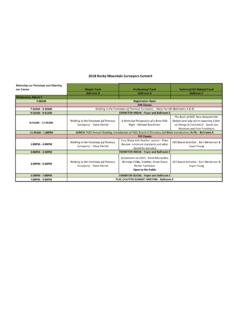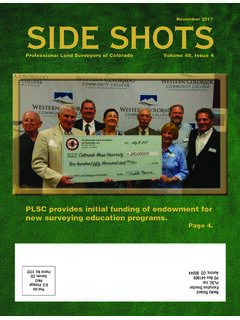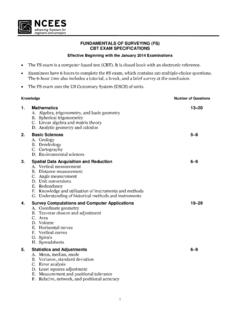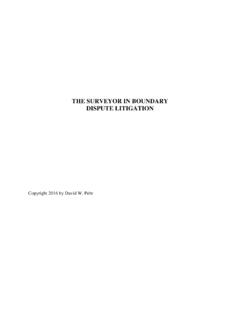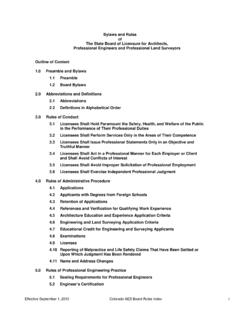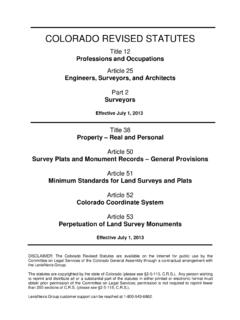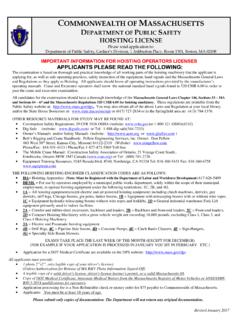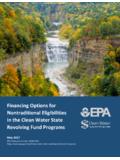Transcription of COMPILATION OF STATE LAWS AND REGULATIONS …
1 COMPILATION OF STATE laws AND REGULATIONS affecting highway - rail grade CROSSINGS 5TH EDITION OCTOBER 2009 The COMPILATION of STATE laws and REGULATIONS affecting highway - rail grade Crossings 5th Edition was prepared by: By L. Stephen Jennings Jennings Consulting Group 713 W. Spring St Woodstock, VA 22664 In conjunction with members of the Federal Railroad Administration DISCLAIMER This COMPILATION is intended to present the laws of the various jurisdictions as of July 2009. Every effort has been made to ensure accuracy. However, due to the broad scope of this project and the fluid nature of STATE statutory law, the author cannot guarantee complete accuracy of the material presented. In addition, a number of states have not published all of the updates to their laws from the work of their 2009 legislative sessions. This COMPILATION is intended to provide a general overview of the laws and REGULATIONS contained in all fifty states and the District of Columbia.
2 For more detailed and up-to-date information, the reader is encouraged to review the relevant STATE statutes and annotations directly. A great deal of material was reviewed during the preparation of this book, and during the research and preparation process, it is possible that something was omitted or misquoted. Any such omissions or misquotes or typing errors are those of the author and not the responsibility of the Department of Transportation or the Federal Railroad Administration. The publishing of this COMPILATION does not constitute the rendering of legal advice in any jurisdiction. L. Stephen Jennings Woodstock, Virginia TABLE OF CONTENTS CHAPTER 1: CROSSING CONSOLIDATIONS AND CHAPTER 2: CROSSING TREATMENT CHAPTER 3: BLOCKED CHAPTER 4: WARNING DEVICES CHAPTER 5: WARNING DEVICES TRAIN CHAPTER 6: WARNING DEVICES CHAPTER 7: SLOW, LOW, AND SPECIAL CHAPTER 8: DRIVER CHAPTER 9: CHAPTER 10: CHAPTER 11: PRIVATE CHAPTER 12: VEGETATION CHAPTER 13: PHOTOGRAPHIC MONITORING AND iPREFACE The COMPILATION of STATE laws and REGULATIONS on Matters affecting highway - rail grade Crossings, Fifth Edition makes a unique contribution to the highway - rail grade crossing safety literature.
3 This book represents the Fifth Edition of the original 1983 publication. Beginning with the Second Edition, a portion of the original title was changed from rail - highway grade Crossings to highway - rail grade Crossings. The Second Edition, published in 1995, broadened the scope to include an examination of laws in the various states and the District of Columbia concerning trespassing on railroad facilities, vandalism to railroad property, and the degree of local government control, if any, over private crossings. In the Third Edition, the parameters of the examination were again expanded to include two additional chapters covering vegetation clearance and photographic enforcement. These additional chapters reflect the increased concern among government policy makers, railroads, and STATE and regional transportation agencies regarding grade crossing safety as we usher in the era of the high-speed train.
4 Additionally, the Third Edition added a number of applicable sections from the Uniform Vehicle Code (UVC) as an appendix to serve as an additional resource and to provide a means of comparison. The UVC was first published in 1926 and designed as a specimen set of motor vehicle laws intended to be used as a model for states to adopt. It has been updated many times and continues to serve as a valuable framework for the development of STATE legislation. Each chapter in this book represents a different subject area and each chapter s contents are summarized in an effort to provide the reader with a brief overview of the subject matter presented. The laws of each individual STATE and the District of Columbia relative to the subject matter are presented, either verbatim, or, in many instances, paraphrased for clarity and better understanding. Each subject area is addressed from a practical orientation, making it an invaluable resource for a variety of users.
5 Added to this Fifth Edition is a quick reference page to facilitate browsing. Although, in most instances, the book is written in everyday language for use by laymen, it is also intended to serve as a comprehensive legal reference and a practical tool for legislators, policymakers, and lawyers. This book is available on the Internet at the Federal Railroad Administration s Office of Railroad Safety Web site. This book was originally prepared under the sponsorship of the Federal Railroad Administration s Office of Railroad Safety with technical assistance provided by the Office of Chief Counsel. The author acknowledges with sincere appreciation the contributions of Messrs and Ron Ries and Michail Grizkewitsch with the Federal Railroad Administrations Office of Safety, highway - rail grade Crossing & Trespassing Division. Additional gratitude goes to each of the FRA s regional highway - rail grade Crossing Safety and Trespass Prevention managers for their help and for a job well done.
6 IiINTRODUCTION BACKGROUND The Federal Railroad Administration has identified roughly 258,815 public and private highway - rail grade crossings in the United States. Most aspects of jurisdiction over highway - rail grade crossings reside with the states. Within some states, responsibility is divided between several public agencies and the railroad. In other states, jurisdiction over highway - rail grade crossings is assigned to a regulatory agency with various names such as the Public Utility Commission, Public Service Commission, or STATE Corporation Commission. Still, other states divide the authority among public administrative agencies of the STATE , county, city, and town, having jurisdiction and responsibility for their respective highway systems. STATE and local law enforcement agencies have the responsibility for the enforcement of traffic laws at highway - rail grade crossings. In a number of cases, local government bodies are given responsibility for certain operational matters related to crossings; and this is accomplished through various ordinances.
7 PURPOSE AND SCOPE This COMPILATION of STATE laws and REGULATIONS on Matters affecting highway - rail Crossings, Fifth Edition is intended to provide an up-to-date and more expansive look at the various STATE laws and REGULATIONS concerning every aspect of the regulation of highway - rail grade crossings, and driver behavior at those crossings. Compiled here are all of the laws and REGULATIONS of the 50 states and the District of Columbia into one comprehensive, easy-to-use document. It is intended to provide a one-stop reference for researchers, engineers, students, legal practitioners, and those individuals who make their living working in the field of highway - rail grade crossing safety. The reader will find this Fifth Edition useful when assessing differences and similarities in the laws among states, seeking distinctions between desirable and undesirable laws , and when conducting legal research.
8 The source material collected for this book was obtained from individual STATE legislative Web sites which contain the laws and REGULATIONS published by each STATE and the District of Columbia. The style of legal citation used in this Fifth Edition is obtained from The Bluebook: A Uniform System of Citation, Seventeenth Edition, Cambridge, Mass. (Harvard Law Review Association, 2000.) 1-1 CHAPTER 1: CROSSING CONSOLIDATIONS AND CLOSURES CHAPTER OVERVIEW In the majority of states, the overall authority for highway - rail grade crossing safety, and the authority to order the elimination of at- grade crossings is conferred upon the STATE agency that regulates and oversees transportation. In a small number of states, the responsibility for crossing elimination is vested in regulatory bodies. These entities are referred to by various names, such as the public utilities commission and the STATE corporation commission.
9 A couple of states provide for collective responsibility between a STATE agency and a unit of local government, while a few more provide for shared responsibility between the STATE department of transportation and another STATE agency, such as the highway department. The agency charged with the responsibility for elimination, or abolishment, as the process is often called, has not changed a great deal since the original publication of this book. In the few instances where the responsible agency is different, it was the result of the powers and functions of the agency being assumed by another agency. For example, in Missouri, the exclusive responsibility for altering or abolishing highway - rail grade crossings is now vested in the highways and transportation commission within the department of transportation. Likewise, the Commonwealth of Massachusetts shifted the responsibility for grade crossing consolidations and closures to an agency called the Department of Telecommunications and Energy.
10 The STATE of Texas has also shifted responsibility from the railroad commission to the department of transportation. This chapter provides an overview of the procedures for grade crossing elimination on a STATE -by- STATE basis. The STATE or county agency with statutory authority to order the elimination or consolidation of a grade crossing is identified along with an indication of whether the authority is exclusive or shared and also listed is the statutory responsibility for the costs of replacement or consolidation. Also listed with each STATE is the appropriate citation(s). STATE laws AND REGULATIONS ALABAMA The Alabama Department of Transportation has statutory authority to abandon and discontinue any portion of a STATE highway or street on a STATE highway route with the approval of the city council or governing body of any municipality, crossing the tracks or right-of-way of any railroad or street railway within the STATE , and to close the grade crossings, when, in its judgment, the grade crossing has ceased to be necessary for the public as part of any STATE highway , because of relocation of the highway or because of the construction of an underpass, overpass, or other provision made for the elimination of the grade crossing.
